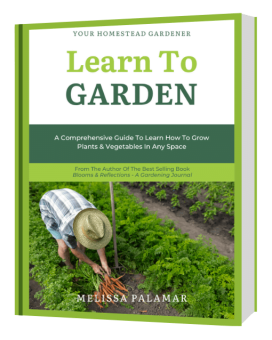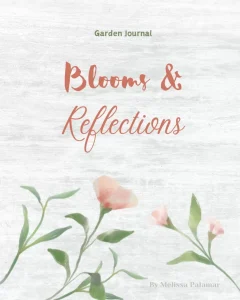Disclosure: This page may contain affiliate links. In the event of a sale, I will be awarded a small commission (at no cost to you).
Garden Plan: Cultivate Success Crafting Your 2024 Food Garden
Now that the festivities of Christmas are behind us, gardeners are turning their attention to the promise of spring. The allure of getting our hands dirty, cultivating vibrant greens, and tasting the fruits of our labor is irresistibly beckoning. In this article, I’ll delve into the art of planning a food garden for the upcoming year, exploring the reasons behind creating a plan, avoiding common mistakes, the steps to build a comprehensive plan, and the invaluable insights a garden journal can provide.
The Benefits of Creating a Garden Plan
Embarking on a gardening journey without a plan is akin to setting sail without a compass; you may drift aimlessly and encounter unforeseen storms. For new gardeners, the act of creating a garden plan is a pivotal step towards cultivating success and reaping the rewards of their efforts. A garden plan serves as a roadmap, guiding you through the intricate world of horticulture. It provides a structured framework to understand and harness crucial factors such as space, sunlight, and plant compatibility.
This blueprint not only helps avoid common pitfalls like overcrowding but also instills confidence by breaking down the overwhelming task of gardening into manageable steps. With a plan in hand, new gardeners can approach their endeavor with purpose, making informed decisions about what to grow, where to plant, and how to nurture their garden to fruition. The benefits extend beyond the initial planting, fostering a sense of accomplishment and a deeper connection to the natural cycles of growth, ultimately transforming novices into seasoned and successful gardeners.
- Avoiding Costly Mistakes: One of the primary advantages of crafting a garden plan is the ability to sidestep costly errors. Overcrowding, for example, can lead to disease and pest infestations that can decimate an entire crop. A well-thought-out plan ensures proper spacing and allows for healthier, more robust plants.
- Organized Record-Keeping: A garden plan acts as a comprehensive record of your gardening journey. It tracks what’s growing, where it’s planted, the planting dates, watering schedules, time to harvest, and environmental conditions affecting growth. This organized approach is indispensable for efficient garden management.
- Resource Optimization: Planning enables you to make the most of your available resources, be it space, sunlight, or water. This optimization is crucial for maximizing yields and minimizing waste.
- Enhanced Plant Health: By understanding the needs of each plant, you can create an environment that fosters optimal growth. A well-structured plan allows you to tailor your garden to specific plant requirements, leading to healthier and more productive crops.
- Time Management: Having a plan in place helps you manage your time effectively. You’ll know when to plant, water, fertilize, and harvest, reducing guesswork and ensuring a well-organized and timely garden.

Want to learn how to grow like a Pro?
Unlock the secrets of a thriving garden! Enter your email below to get your FREE copy of ‘Learn to Garden‘ the essential guide that turns budding enthusiasts into green-thumb maestros. Let’s cultivate your gardening journey together, one leaf at a time!
Steps to Creating a Garden Plan
1) Consider/Design Your Space
As you embark on the journey of cultivating your garden, the pivotal first step involves a thoughtful consideration and design of your gardening space. Before the initial seed finds its place in the soil, it is crucial to conduct a meticulous evaluation, taking into account various factors that will influence the success of your green haven. Begin by assessing the available room, envisioning a garden layout that optimizes space to facilitate both plant placement and growth. Delve into the intricacies of sunlight exposure, understanding the patterns that grace your garden to strategically position plants for their optimal development. Consider the unique climate conditions of your location and align your choices with plants that thrive in this specific environment, ensuring a flourishing garden. Finally, bring all these elements together by crafting a thoughtful layout that not only maximizes available space but also promotes efficient care, laying the foundation for easier maintenance in the long run.
2) Decide What to Grow
In the vast tapestry of gardening possibilities, the decision of what to grow is a pivotal and often challenging one, particularly for those venturing into the realm of gardening for the first time. The key to success lies in approaching this choice with a strategic mindset, and for newcomers, the sage advice is to start small.
In the kaleidoscope of plant options, focusing on what you genuinely enjoy eating not only ensures a more rewarding experience but also hones in on the practicalities of managing a burgeoning garden. For those new to the art of cultivating the earth, the mantra is to keep it simple and manageable. Instead of succumbing to the temptation of an extensive variety, consider beginning with a carefully curated selection – perhaps your top three favorite vegetables.
This deliberate curation not only minimizes the risk of overwhelming yourself with the intricacies of diverse plant needs but also provides an opportunity to master the fundamental aspects of gardening. In essence, starting small becomes a foundational step, allowing you to cultivate both the plants in your garden and your burgeoning green thumb with confidence.
3) Consider Companion Planting
In the intricate dance of gardening, where each plant plays a unique role in the ecosystem, the concept of companion planting emerges as a strategic and environmentally conscious practice. At its core, companion planting involves the intentional arrangement of plants with the aim of fostering mutually beneficial relationships or impeding the growth of pests. This approach is akin to orchestrating a symphony in the garden, where each plant harmonizes with its neighbors. Delving deeper into this horticultural strategy, it becomes imperative to grasp the nuances of what plants flourish or falter when positioned alongside one another.
Understanding what can grow harmoniously together becomes an artful science in itself. Certain plants, when strategically placed side by side, exhibit a synergistic relationship that not only enhances their growth but also serves as a natural defense mechanism against pests. This symbiosis in the garden is a testament to the wisdom of nature, where certain plants act as protectors and nurturers to their botanical companions.
Conversely, recognizing the dynamics of what plants do poorly when planted in close proximity is equally crucial. Some plants, like incompatible neighbors, can inadvertently hinder each other’s growth or, even worse, attract pests that threaten the vitality of the entire garden. Navigating this delicate dance of plant interactions requires a discerning eye and an understanding of the intricacies of each species’ needs and tendencies.
In essence, companion planting becomes a nuanced strategy that transcends the mere placement of plants; it is an artful orchestration that taps into the hidden symphony of nature, fostering a harmonious and thriving garden.
4) Come Up With a Water/Feed Schedule
In the rhythmic heartbeat of a thriving garden, the establishment of a well-defined watering and feeding schedule emerges as a fundamental melody. This harmonious cadence is not merely a routine but a critical factor in nurturing the vitality of your plant companions. Delving into the intricacies of crafting an effective plan, several considerations come into play, each contributing to the symphony of plant health.
The first note to hit is the decision between drip irrigation or a traditional hose system, a choice that hinges on the unique contours of your garden layout. This pivotal decision shapes the flow of life-giving water, determining the efficiency and effectiveness of your watering strategy.
Moving on, understanding the individual needs of your green charges is paramount. Each plant, akin to a unique instrument in an orchestra, requires a specific balance of water and fertilizer. Identifying which plants thirst for more hydration and which thrive in drier conditions forms the essence of this horticultural composition.
In the grand orchestration of garden care, the implementation of best practices for watering takes center stage. “Bottom feeding,” a technique that involves directing water at the base of plants rather than showering them from overhead, is a key crescendo in this melody. This practice not only conserves water but also minimizes the risk of fungal diseases and optimizes the delivery of nutrients to the roots.
In essence, crafting a water/feed schedule is an artful endeavor that blends the technical aspects of irrigation systems with the nuanced understanding of each plant’s unique requirements. As you conduct this symphony of care, you become the conductor, orchestrating a harmonious rhythm that resonates through the soil, nurturing your garden into a flourishing masterpiece.
5) Track Your Progress
In the realm of gardening, the success of your meticulously crafted garden plan hinges not only on the initial planning stages but also on the ongoing practice of tracking your progress. It is through this systematic monitoring that you gain invaluable insights into the dynamics of your garden’s growth.
A fundamental aspect of tracking involves keeping a comprehensive record of key milestones in your garden’s life cycle. Documenting planting dates, growth patterns, and harvest yields allows you to observe and analyze the unique journey each plant undergoes.
The process of tracking extends beyond mere documentation; it involves a conscious effort to note mistakes and engage in reflective practices. By acknowledging and learning from challenges encountered along the way, you empower yourself to adapt and fine-tune your plan for greater effectiveness.
A helpful tool in this tracking endeavor is the use of a dedicated garden journal. Consider incorporating my garden journal “Blooms and Reflections“ which is available on Amazon, into your gardening routine. This specialized journal streamlines the tracking process, providing a structured platform to record observations, insights, and adjustments made throughout the gardening season. Integrating such a journal into your routine not only enhances the efficiency of your tracking but also serves as a tangible and rewarding documentation of your evolving gardening expertise.

The Only Garden Journal You'll Ever Need!
Embark on a journey through the seasons with ‘Blooms and Reflections‘ your companion in cultivating the garden of your dreams. This beautifully crafted gardening journal unfolds over 91 pages, offering a comprehensive space for all your gardening aspirations and practical needs.
Conclusion
In conclusion, creating a solid garden plan is the cornerstone of a successful and bountiful harvest. The benefits, including avoiding mistakes, organized record-keeping, resource optimization, enhanced plant health, and efficient time management, underscore the importance of thoughtful planning. By following the steps outlined and consistently tracking your progress, you’re not only setting yourself up for a thriving garden in 2024 but also cultivating a deeper understanding and appreciation for the art of gardening.





